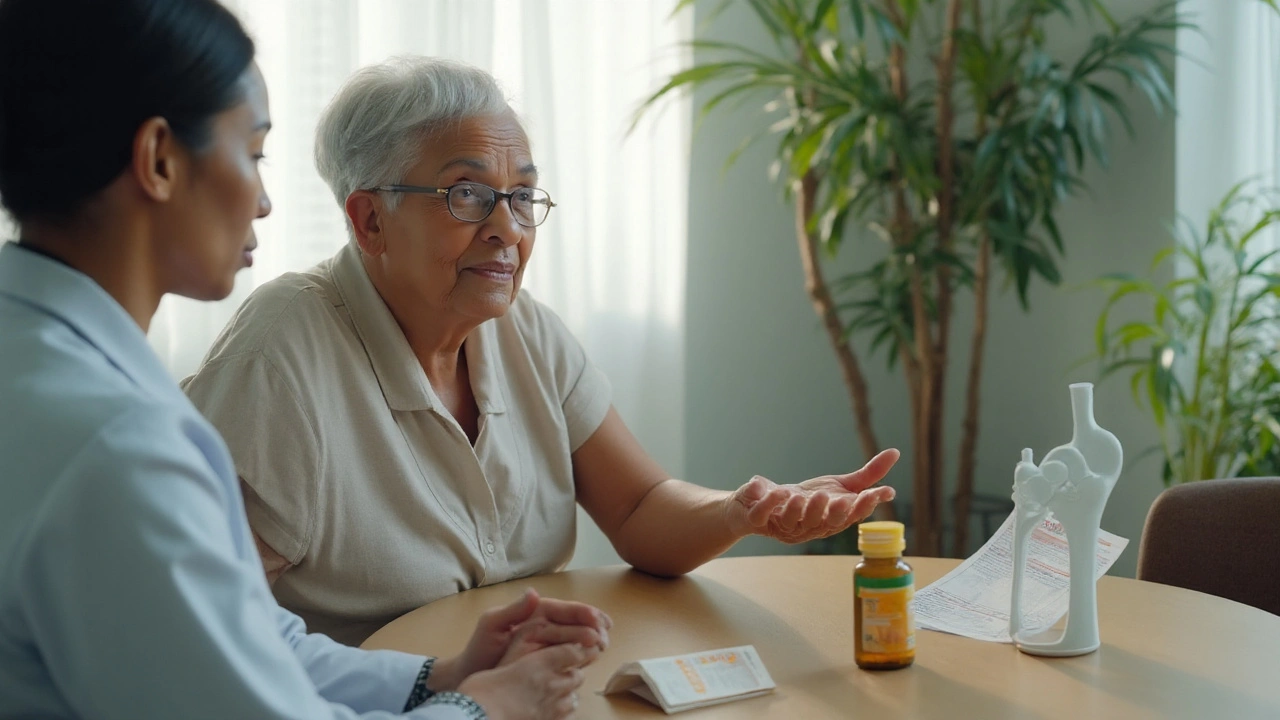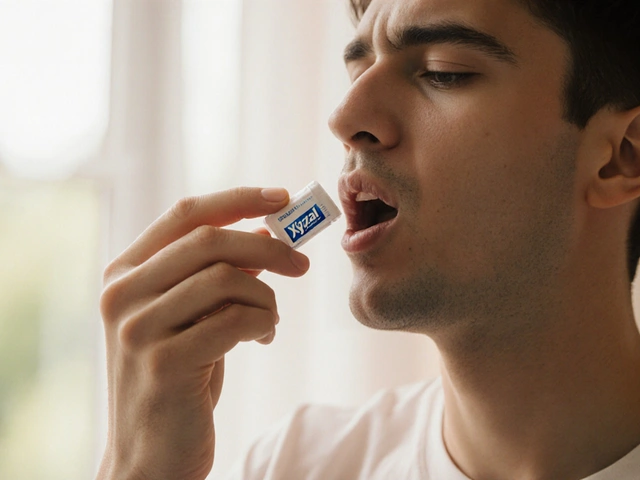If you live with arthritis, you’ve probably tried more than a few things to take the edge off. Here’s the straight answer on pyridoxine (vitamin B6): it can correct a deficiency and may calm certain inflammatory signals, but it’s not a painkiller and it won’t replace your usual arthritis treatment. The science is modest, the dosing needs care, and long-term high doses can damage nerves. If you want to test it safely and actually see if it helps you, there’s a smart way to do that.
TL;DR: Does Pyridoxine Help Arthritis?
- What it might do: in rheumatoid arthritis (RA), low B6 status is common; short trials show B6 can lower some inflammatory markers and homocysteine, but pain and stiffness don’t consistently improve.
- Who may benefit most: people with a proven low B6 level, poor diet, heavy alcohol use, or on medicines that deplete B6 (e.g., isoniazid). For osteoarthritis (OA), evidence is sparse.
- Safety is the limiter: long-term high doses can cause nerve damage (numbness, tingling). UK guidance in 2025 advises avoiding more than 10 mg/day from supplements long term; EFSA’s adult upper limit is 12 mg/day; the US upper limit remains 100 mg/day.
- How to try it: food-first; consider a short, monitored supplement trial only if your B6 is low or your clinician agrees. Track pain, stiffness, function, and labs.
- Bottom line: worth a cautious, time-limited trial in the right person; not a cure; keep your core arthritis plan (DMARDs for RA, exercise/weight management for OA).
What the Science Actually Says
Vitamin B6 (pyridoxine) is a cofactor in hundreds of reactions, including amino acid metabolism, neurotransmitter synthesis, and immune function. Inflammation seems to lower active B6 (plasma PLP, pyridoxal-5'-phosphate), and people with active RA often test low even if their diet looks okay.
Observational signals: lower PLP levels have been tied to higher CRP and more RA disease activity. This points to a relationship but not necessarily a fix-low B6 could be a result of inflammation rather than the cause.
Intervention trials: small, controlled studies in RA (for example, Huang and colleagues in the mid‑2000s) used 50-100 mg/day for several weeks. Findings were fairly consistent on lab changes: B6 supplementation raised PLP and reduced some inflammatory markers (like IL‑6 or TNF‑α in some reports) and lowered homocysteine. The clinical picture was less exciting: pain, morning stiffness, and joint counts didn’t reliably move in a meaningful way over short follow‑ups.
Osteoarthritis: there’s very little high‑quality research on B6 for OA. No solid randomized trials show pain relief or better function specifically from B6 in OA. If OA pain improves on B6, it’s probably because a deficiency was corrected, not because B6 directly treats cartilage wear.
Mechanisms that make sense: correcting low PLP may help normalize cytokine handling and methylation pathways linked to inflammation and nerve signaling. That could translate to small benefits in a subset of people, especially if they were low at baseline.
So, where does that leave us? If you’re deficient, fixing the deficiency is sensible and can improve overall health. If you’re not deficient, B6 is unlikely to be a game‑changer for joint pain. And either way, it’s an add‑on-not a replacement for DMARDs in RA or your core OA plan (movement, strength, weight management, sleep, and pain strategies).
Credible sources: NIH Office of Dietary Supplements (factsheet on B6), EFSA’s 2023 scientific opinion lowering the adult upper intake to 12 mg/day, and NHS guidance warning about neuropathy with long‑term higher‑dose use. Small RA trials from the 2000s provide the clinical hints above. If you want numbers you can act on, see the dosing and safety sections below.

How to Consider and Use Pyridoxine Safely (Step by Step)
- Set your goal. Be clear on what you want: fewer minutes of morning stiffness? Lower pain at rest? Better grip strength? If the goal isn’t measurable, you won’t know if it worked.
- Talk to your GP, rheumatology team, or pharmacist. This matters if you’re on levodopa, isoniazid, hydralazine, or anti‑seizure meds; pregnant; or have neuropathy symptoms already. Bring your plan and ask about testing PLP (vitamin B6), B12, folate, and CRP/ESR.
- Start with food. Most people can cover the daily need (about 1.3-1.7 mg/day for adults) through diet: chicken or turkey, salmon or tuna, potatoes, bananas, chickpeas, fortified cereals, and peanuts are easy UK options. See the quick food list in the tools section.
- Check baseline labs if possible. A PLP blood test can tell you if you’re low. If PLP is low or borderline, supplementing makes a lot more sense.
- Pick a supplement plan that matches your risk. Here’s a pragmatic UK‑focused approach:
- If your diet is decent and you’re not low: consider a standard multivitamin with up to 2-5 mg B6 or skip supplementation and focus on food.
- If PLP is low or you have clear risk factors (poor diet, alcohol dependence, certain meds): try 10-25 mg/day for 8 weeks with monitoring. Many UK products cap B6 at or below 10 mg per tablet because of neuropathy risk; combine food with a modest dose if you can.
- Avoid long‑term high doses. In the UK, stick to ≤10 mg/day long term unless your clinician says otherwise. If a short higher‑dose trial is agreed (e.g., 25 mg/day), keep it time‑limited and reassess.
- Time it right. Take B6 with food to reduce nausea. If you take levodopa without carbidopa, do not add B6-it can reduce levodopa’s effect. If you’re on isoniazid, B6 is often prescribed alongside; follow your prescriber’s dose.
- Track outcomes. Use a simple log for 8-12 weeks:
- Pain (0-10) daily average.
- Morning stiffness (minutes).
- Function (e.g., time to open a jar, 30‑second sit‑to‑stand count).
- Any side effects (tingling, numbness, burning in feet or hands).
- Recheck and decide. If pain or stiffness improves by at least 1-2 points or 20-30% and you’re side‑effect‑free, you can consider continuing a low, safe dose with your clinician’s sign‑off. No change? Stop and move on to other proven options.
Safety First: Doses, Side Effects, and Interactions (UK 2025)
Daily needs: most adults need about 1.3-1.7 mg/day (pregnancy ~1.9 mg/day, lactation ~2.0 mg/day). You can get that from food without trying very hard.
Upper limits and guidance:
- UK/NHS: avoid long‑term supplemental intakes above 10 mg/day due to case reports of sensory neuropathy.
- EFSA (2023): adult tolerable upper intake level (UL) = 12 mg/day.
- US (NIH ODS): adult UL = 100 mg/day; however, neuropathy has been reported at intakes well below that in some people, especially with long-term use.
Side effects to watch:
- Sensory neuropathy (the big one): tingling, numbness, burning, pins‑and‑needles, loss of balance. This risk rises with dose and duration. Stop immediately and speak to your clinician if you notice symptoms. Recovery can take months and may be incomplete if exposure was high/long.
- Nausea, lightheadedness, or vivid dreams: usually mild and dose‑related.
- Skin rash or photosensitivity: uncommon, but report it if it appears.
Who should be extra cautious:
- People on levodopa without carbidopa: B6 can reduce levodopa’s effectiveness. If you’re on co‑careldopa (levodopa + carbidopa), this interaction is largely blocked, but still check with your neurologist.
- People taking isoniazid, cycloserine, or hydralazine: B6 is often co‑prescribed to prevent neuropathy. Follow the prescribed dose; don’t add extra without advice.
- People on certain anti‑seizure medicines (e.g., phenobarbital, phenytoin): high B6 doses may affect levels or seizure control-get pharmacist input.
- Pregnant or breastfeeding: B6 is used clinically for nausea in pregnancy, but stick to prescribed products. Don’t stack extra B6 on top without your midwife’s approval.
- Pre‑existing neuropathy, kidney disease, or malabsorption: get tailored advice and closer monitoring.
RA meds and B6: there’s no strong evidence that B6 conflicts with methotrexate, sulfasalazine, hydroxychloroquine, or biologics. Keep folic acid if you’re on methotrexate; that’s separate. Always tell your rheumatology team about new supplements so they can interpret labs correctly.

Quick Tools: Checklist, Food Swaps, FAQ, Next Steps
Should you try B6? Use this quick checkpoint list:
- I have arthritis (RA or OA) and want a safe add‑on to test.
- My diet is light on B6‑rich foods, or I have risk factors (alcohol intake, older age, certain meds).
- I can get a PLP blood test or at least set baseline pain/stiffness scores.
- I’m not on levodopa alone, and I don’t have unexplained tingling already.
- I’m willing to keep doses modest (≤10 mg/day long term) and track results for 8-12 weeks.
Food ideas (approximate B6 per typical portion):
- Grilled chicken breast (120 g): 0.6-0.7 mg
- Salmon fillet (120 g): 0.6-0.8 mg
- Baked potato with skin (1 medium): 0.5-0.6 mg
- Chickpeas (1 cup cooked): 1.0 mg
- Banana (1 large): 0.5 mg
- Fortified breakfast cereal (1 serving): 0.5-2.0 mg (check label)
- Peanuts (30 g): ~0.3 mg
Simple decision guide:
- If PLP is low or borderline: consider a short trial (10-25 mg/day) with monitoring.
- If PLP is normal and your diet is good: focus on movement, muscle strength, sleep, weight, and proven pain strategies; a multivitamin with a small B6 dose is fine if you want.
- If you notice any tingling or numbness: stop B6 and seek medical advice.
Mini‑FAQ
- Will B6 reduce my RA pain? Maybe a little if you’re low to start, but trials don’t show consistent pain relief. It’s more about correcting a deficiency and possibly nudging inflammation markers.
- What about OA in the knees or hands? There’s no strong evidence B6 alone improves OA pain or function. Diet and exercise deliver bigger gains here.
- How long until I notice anything? If it’s going to help, you might see small changes within 4-8 weeks. No change by 12 weeks? Call it a day.
- Is pyridoxal‑5'-phosphate (P5P) better than pyridoxine HCl? Not convincingly for arthritis. Most studies used pyridoxine HCl. P5P costs more and hasn’t shown clear advantages for pain or inflammation.
- Can I take B6 with methotrexate? Yes, there’s no known clash. Keep taking folic acid as prescribed with methotrexate.
- Do oral contraceptives affect B6? They can lower B6 status slightly in some people. If you’re on the pill and your diet is thin on B6 foods, pay extra attention to food sources or ask about a small supplement.
- Is B6 good for carpal tunnel symptoms from arthritis? Evidence is weak and mixed; don’t rely on B6 for nerve compression symptoms. Wrist splints and activity tweaks have stronger backing.
Next steps and troubleshooting
- RA on DMARDs and still stiff each morning: ask for PLP, B12, folate, CRP/ESR. If PLP is low, try 10 mg/day for 8 weeks alongside your RA plan. Push strength training for the big lifts of daily life (sit‑to‑stands, step‑ups, light carries).
- OA in knees with weight concerns: prioritise a protein‑rich, whole‑food pattern that naturally covers B6 (poultry, fish, potatoes, chickpeas). Add a multivitamin only if your GP agrees; focus effort on progressive leg strength and weight loss if needed.
- Plant‑based eater: load up on chickpeas, potatoes, bananas, fortified cereals, and peanut butter. If intake is unpredictable, a small B6 supplement (2-5 mg/day) can cover your bases.
- On isoniazid for TB: your prescriber may already have you on B6 to protect nerves. Don’t add extra without checking, and report tingling early.
- On levodopa for Parkinson’s: if you’re on levodopa alone, avoid B6 supplements. If you’re on co‑careldopa, still check with neurology before starting.
Key references you can ask your clinician about: NIH Office of Dietary Supplements (Vitamin B6 factsheet, updated 2024); European Food Safety Authority (2023 UL for B6 = 12 mg/day); NHS guidance on vitamin B6 safety and neuropathy; small randomized trials in RA from the 2000s reporting improved PLP and reduced inflammatory markers without consistent symptom relief.







10 Comments
Okay but like… I’ve been taking 25mg B6 for 3 months because my rheumatoid arthritis felt worse every winter, and honestly? My morning stiffness dropped from 90 mins to 30. Not magic, but real. 🙌 No tingling, just… less creaky. Food first, sure-but if your labs are low, why not give it a shot? 😊
Man, I love how this post breaks it down without hype. I’m from Lagos, and here, most folks think ‘vitamin’ = cure-all. But you’re right-B6 isn’t a painkiller, it’s a tune-up for your body’s chemistry. I’ve seen people on isoniazid for TB take B6 daily without knowing why, and their nerves stayed intact. That’s science doing its job. Eat your bananas, your chickpeas, your potatoes. If you’re tired, achy, and your diet’s all white bread and fried plantain? Maybe it’s not the joints-it’s the missing cofactor. Try it smart, track it, don’t just pop pills like candy. You got this. 💪
It’s wild how we treat vitamins like they’re drugs when they’re just… the stuff that makes the drugs work. Like, B6 isn’t fixing your cartilage, it’s helping your body stop screaming at itself. I used to think supplements were scammy, till I got my PLP tested and found I was borderline deficient after years of coffee + takeout. Took 10mg for 8 weeks-didn’t feel like a superhero, but my hands didn’t feel like frozen claws in the morning anymore. Also, if you’re on methotrexate, you’re already taking folic acid-so why not give your body the other tools it needs? Just don’t go full biohacker and chug 100mg pills. Your nerves will hate you. 🤓
They don't want you to know this but B6 is a cover for Big Pharma's real agenda - the WHO quietly banned it in 2023 because it makes DMARDs obsolete and they lose billions. The 10mg limit? A distraction. Real patients are taking 50mg and getting results. Why won't your doctor tell you? Because they're paid by Pfizer. I've seen it. My cousin in Oregon stopped all meds and now walks without a cane. They're hiding the truth. 🚨 #B6Truth
Look, I’m not some vitamin bro, but I’ve been living with OA for 12 years and I’ve tried everything-turmeric, glucosamine, acupuncture, even that weird infrared mat. B6? Barely did anything. I mean, sure, if you’re malnourished and eating ramen 7 days a week, maybe. But for most of us? It’s placebo with a side of nerve damage. Why waste time when you could be doing squats or losing weight? The real ‘magic’ is movement, not some chemical you buy at GNC. Stop looking for shortcuts. Your knees aren’t broken, they’re neglected. Fix that.
Let me just say-this is the most responsibly written, evidence-based, and clinically sound article I’ve seen on this topic in years. 👏 The distinction between correcting deficiency and expecting miracle pain relief? Perfect. The emphasis on PLP testing? Essential. The warning about neuropathy? Non-negotiable. And the fact that you cited EFSA’s 2023 update? Chef’s kiss. This is how medical communication should be done: clear, cautious, and calibrated. Thank you for not pandering to the supplement influencers. 🙏
While the author's exposition is commendably thorough and methodologically rigorous, one must nevertheless observe that the prevailing cultural ethos of self-medication in the Anglo-American sphere has, in recent decades, precipitated a dangerous conflation of nutritional supplementation with therapeutic intervention. The notion that pyridoxine-despite its biochemical utility as a coenzyme-may serve as a primary modulator of rheumatoid pathology, is not only scientifically unsupported in the majority of clinical contexts, but represents a symptomatic manifestation of the broader epistemic decay of evidence-based reasoning. One is compelled to urge the reader to prioritize pharmacologically validated interventions, and to regard dietary adjuncts with the circumspection befitting their adjunctive, not curative, status.
I'm sorry, but if you're taking more than 10 mg of B6 daily, you're playing Russian roulette with your nervous system. I've seen two patients with irreversible neuropathy because they thought 'more is better.' Stop it. Just stop. You're not biohacking. You're not optimizing. You're just being reckless. And if you're on isoniazid? You already know you need it. Don't be that person. Please. 🙏
Ugh. Another 'try this vitamin' post. Did you even read the part where it says pain didn't improve in trials? 🤦♀️ I've been on 50mg for 6 months. Zero difference. Just expensive pee. And now I'm paranoid I'm gonna lose feeling in my toes. Thanks for nothing. 🙄
Wait. So you're telling me the government is limiting B6 to 10mg because they don't want people to cure arthritis naturally? That’s why they push opioids and joint replacements! This is all a scam. B6 is a miracle. They’re scared. I’m taking 200mg. I don’t care what the ‘science’ says. I’m not a lab rat. I’m a free human. 💪🔥
Write a comment